Serendip is an independent site partnering with faculty at multiple colleges and universities around the world. Happy exploring!
Remote Ready Biology Learning Activities

These minds-on activities, initially designed for use in the classroom, have been adapted for use in online teaching or distance learning. Advice for Using Google Docs is available at https://serendipstudio.org/exchange/bioactivities/Googledocs.
Introductory Activities- Characteristics of Life
- Levels of Organization in Biology
- Coronaviruses – What They Are and How They Can Make You Sick
- Introduction to the Functions of Proteins and DNA
- Cells – How do they carry out the activities of life?
- Why do some plants grow in odd shapes?
- How do organisms use energy?
- Using Models to Understand Cellular Respiration
- Using Models to Understand Photosynthesis
- Food, Physical Activity, and Body Weight
- How do muscles get the energy they need for athletic activity?
- Plant Growth Puzzle – Photosynthesis, Biosynthesis, and Cellular Respiration
- Where does a tree’s mass come from?
- Mitosis and the Cell Cycle – How the Trillions of Cells in a Human Body Developed from a Single Cell
- Understanding How Genes Are Inherited via Meiosis and Fertilization
- Comparing Mitosis and Meiosis
- Melanoma, Mutations and Abnormal Cell Cycles
- How Mistakes in Meiosis Can Result in Down Syndrome or Death of an Embryo
- Introduction to Genetics – Similarities and Differences between Family Members
- The Genetics of Sickle Cell Anemia and Sickle Cell Trait
- Genetics and Probability – Sex Ratios of Births
- A mistake in copying DNA can result in dwarfism
- Soap Opera Genetics – Genetics to Resolve Family Arguments
- Learning about Genetic Disorders
- DNA Function, Structure and Replication
- How Genes Can Cause Disease – Understanding Transcription and Translation
- Mutations and Muscular Dystrophy
- Why and How Your Body Makes Millions of Red Blood Cells Every Minute
- Genetic Engineering Challenge – How can scientists develop a type of rice that could prevent vitamin A deficiency?
- Gene Editing with CRISPR-Cas – A Cure for Severe Sickle Cell Anemia?
- What is natural selection?
- Natural Selection and the Peppered Moth
- How have mutations and natural selection affected fur color in mice?
- How Whales Evolved – Evidence and Scientific Arguments
- How Eyes Evolved – Analyzing the Evidence
- What is a species?
- Coronavirus Evolution and the COVID-19 Pandemic
- How Animals Adapt to Their Environments – Examples and Evolution
- Understanding and Predicting Changes in Population Size – Exponential and Logistic Population Growth Models vs. Complex Reality
- Stability and Change in Biological Communities
- Food Webs - How did the elimination and return of wolves affect other populations in Yellowstone?
- Carbon Cycles and Energy Flow through Ecosystems
- Trophic Pyramids
- Introduction to Global Warming
- Food and Climate Change – How can we feed a growing world population without increasing global warming?
- Coral Bleaching
- The Ecology of Lyme Disease











